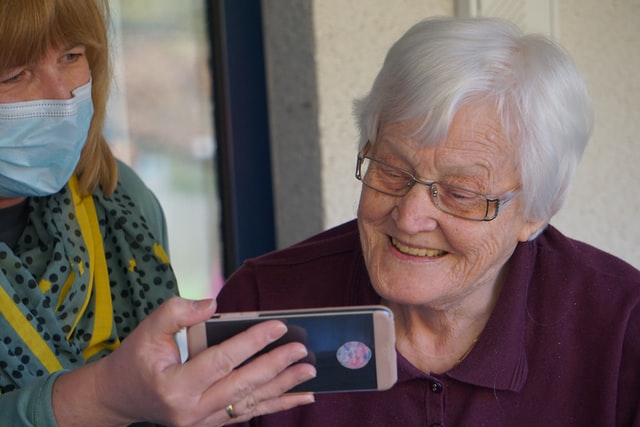Determining the right living arrangement for your senior is much harder now
The decision to place your loved one in a nursing home or another long-term-care facility is a difficult one under any circumstances, especially since most adults would prefer to remain at home. Human nature is such that seniors tend to be in denial and their families tend to put off the decision as long as possible. The result often then limits your senior’s options for care.
As if that were not challenging enough, layering on an analysis that suggests that over 40% of COVID-19 deaths have occurred in nursing homes and assisted living facilities, it’s no wonder that families can easily become paralyzed into inaction.(Source: freopp.org, June 2020. Nursing Homes & Assisted Living Facilities Account for 43% of COVID-19 Deaths by Gregg Girvan and Avik Roy).
Nevertheless, being prepared for this decision – financially and emotionally – can help your loved one make this complicated transition in the smoothest manner possible.
The Choices Seem Endless
There are essentially five categories of care for our seniors, although each of these categories seems to also contain nuanced-care descriptions that requires a slightly different name.
But here are the five main categories:
- Nursing homes are the largest category and offer 24-hour supervision. According to the Centers for Disease Control and Prevention, there are approximately 15,600 nursing homes in the U.S. with 1.7 million licensed beds, occupied by 1.4 million patients. The primary advantage to nursing home care is that patients have access to skilled care 24 hours a day, 7 days a week.
- Assisted living facilities are similar to nursing homes but are for seniors who do not require full-time medical care or as much assistance with daily activities.
- Adult day service centers are similar to assisted living facilities but are usually only open during business hours and are for seniors who require even less medical care and less assistance with daily activities. The CDC estimates that there are approximately 4,600 adult day services centers in the U.S.
- Home health care could be considered similar to the care a senior would receive from a nursing home, but the differences are that the care is delivered by an agency in the senior’s home (or the home of a loved one). The CDC estimates that there are approximately 12,200 home health care agencies in the U.S.
- Hospices are facilities for those with terminal illnesses, often with very few months left to live. The CDC estimates that there are approximately 4,300 hospice care agencies in the U.S.
(Source: Centers for Disease Control and Prevention, National Center for Health Statistics, June 2020).
No matter which category of care your senior needs, all of them can vary greatly in quality of care, so it takes considerable planning and research to ensure the right choice for your loved one. To start, it’s important to know that waiting lists can be very long for the best facilities – up to a year or more. Therefore, the time to arrange for your loved one’s care is before the need arises.
Discuss When Everyone is Healthy
A discussion for moving a parent (or anyone else) to a nursing home is best made when everyone is healthy. Once stricken by illness or frustrated by the loss of mobility and freedom, an older parent may not understand questions or state details of their wishes. In addition, lack of a plan often ignites family arguments without even knowing what the parent would really want.
These talks should go beyond just the money to include the parent’s future independence and decision-making regarding finances, health care and other subjects as well as basic preferences for day-to-day living.
Jumping directly into bank accounts, wills and powers of attorney usually stops the conversation cold. Instead, talk about health and lifestyle issues and then ask where important papers such as a will or power of attorney are kept, how to reach doctors, how household expenses get paid, what specific medicine is needed, etc.
None of these asks about dollars and cents, but instead focus on how your parent lives today and the answers will shape how much more planning is needed.
Your parents’ financial advisor is also a great place to start, as that person knows their situation and about any decisions already made. But make sure you get your parent’s permission first. Their financial advisor can also suggest legal documents to put in place and ways to make sure both parties can access accounts to pay medical and household bills.
Once you feel confident that you understand the current situation, plan a family caregiving strategy meeting.
The reality is that if you wait too long to plan, the likely result might be anger, fear, despair or worry. And you never want to be reactive in your planning, because then your options are limited and much more costly.
Senior Care During COVID-19
You might know that nursing homes and long-term care facilities are required to report all COVID-19 cases to state and local public health officials. But did you know that this mandate just took effect in mid-May? Now, every nursing home in the U.S. is required to:
- Inform its residents and their families within 12 hours of a confirmed COVID-19 case;
- Provide current and past COVID-19 information to the Centers for Disease Control and Prevention; and
- Make the information public.
Remember that estimates by Girvan and Roy that suggest over 40% of COVID-19 deaths have occurred in nursing homes and assisted living facilities? Well, that study actually suggests three different estimates. Taken directly from their work:
“We estimate the national share of nursing and residential care home COVID-19 fatalities in three ways:
Estimate 1 (44.0%): Among states reporting nursing home fatalities, death from COVID-19 has struck 2.5% of U.S. residents of nursing homes and residential care facilities. We estimate that 2.1 million Americans over 65 live in nursing homes and residential care facilities; by extrapolating 2.5% across the entire U.S. nursing and residential care home population, we estimate that nursing homes account for 44.0% of COVID-19 fatalities.
Estimate 2 (43.2%): This is our most simplistic estimate. Among states reporting nursing and residential care home fatalities from COVID-19, nursing homes account for 43.2% of those deaths. If we simply assume that this share holds true in non-reporting states, we get to a national share of 43.2% (i.e., identical to the share in reporting states).
Estimate 3 (51.5%): This estimate excludes New York State, which is an outlier in terms of its reported share of COVID-19 deaths in nursing homes. A number of policymakers in New York have alleged that nursing home facilities in that state have been underreporting their COVID-19 fatality figures, possibly because New York State counts as hospital deaths those of nursing home residents who die in a hospital. It could also be that the high number of non-long-term care deaths in New York explain the lower percentage (i.e., a much larger denominator).”
Sadly, the work of Girvan and Roy is consistent with another study by researchers at the International Long Term Care Policy Network that found close to 41% of COVID-19 fatalities took place in nursing homes. And that study compiled data from facilities in Austria, Australia, Belgium, Canada, Denmark, France, Germany, Hong Kong, Hungary, Ireland, Israel, Norway, Portugal, Singapore, South Korea, Spain, Sweden, and the United Kingdom.
(Source: International Long-Term Care Policy Network, May 2020. Mortality associated with COVID-19 outbreaks in care homes: early international evidence by Adelina Comas-Herrera, Joseba Zalakaín, Charles Litwin, Amy T. Hsu, Natasha Lane and Jose-Luis Fernández).
What Should You Do?
The decision on which senor care facility is an agonizing one and requires online research, multiple site-visits, enormous patience and the willingness to ask a lot of probing questions.
Many facilities have on-staff nursing help with diverse experience in senior needs, as well as readily available medical equipment for specific conditions. Nursing homes are usually affiliated with hospitals, so that a doctor can visit a patient and assess changes in health before your senior needs to be sent to a hospital.
Many facilities offer a choice of living arrangements, such as apartments with kitchens. Services are delivered by a professional onsite staff and include prepared meals, emergency response systems, personal care, social activities, transportation, and housekeeping. And while there are lots of online tools that help you compare facilities (including one at www.medicare.gov), personal visits are essential to helping you make the right decision.
Even if a senior facility is part of a national chain, that doesn’t make their care consistent between sites. You need to visit and ask questions of the staff and residents about safety, customized care, activities, and meal variety. Take the time to find the right fit. Make sure that your loved one is completely comfortable with the environment before making a final decision.
Visiting During COVID-19
Right now and for the foreseeable futures, nursing homes and long-term-facilities are in lockdown, with access limited to essential staff. And federal guidelines suggest outside visitors can only visit during what is called a “compassionate care situation,” which means when a senior is very near death.
Further, when senior facilities do resume allowing visitors and tours, you can bet things will be very different. Right now, most facilities are offering virtual tours, but as everybody knows, virtual tours can be limiting. In other words, your due diligence is much harder today versus what it was in early 2020.
As such, it’s important that you talk to your financial advisor to help you with this decision. Your financial advisor can help connect you with experts, including elder law attorneys, social workers, health care professionals and others that have been through what you are going through.
As always, your financial advisor will provide you truly unbiased advice that has the best interests of you and your family front and center.
Determining appropriate living arrangements for your senior in need is never easy. However, advance preparation, research and your ongoing support will be essential to ensuring the comfort of your senior.
Sources: freopp.org, CDC.org, Itscovid.org, Medicare.gov






